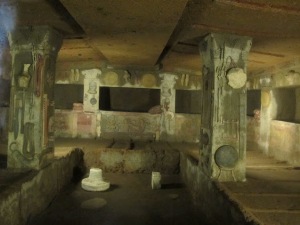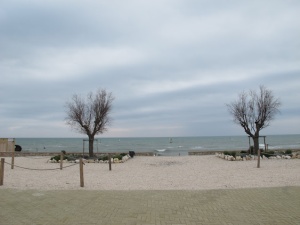When I was in London over Christmas I met my friend Annabel at the British Museum. After coffee and a look at about four things (the BM is free which makes this wonderfully possible) we wandered over to the London Review Bookshop. I vowed I wasn’t going to buy anything. So among my purchases was Etruscan Places, D.H. Lawrence’s book on his journey through Etruria. First published in 1932, it is an intriguing blend of forays into decorated tombs carved into the tuff rock of Etruria, mingled with a palpable and lowering air of menace provided by the omniscient Fascist regime. The remoteness of these towns only 80 years ago astounds; for example the gates of Tarquinia, we are told, are closed at night.
After an intial antipathy towards the Etruscans – too foreign, too mysterious, too different – I came to embrace the perceived exotic otherness several years ago. After all it was, I thought, this mystery which made them so interesting. A people who flourished between the 8th and 5th centuries B.C., ultimately to be swallowed by Rome, whose language is only partially understood, and entirely separate from other European languages. Although written using characters borrowed from Greece, the words are absolutely different. Indeed many letters are reversed, and the script runs from right to left.
The Etruscans may have been indigenous to central Italy, or they may have arrived from Asia Minor (modern Turkey). A people whose art is wholly distinctive and recognisable, but yet also indebted to the Greek and Phoenecian worlds with which they traded. It was the Etruscans who served as the conduit through which elements of the Greek world which we now think of as inescapably Roman were introduced to the Italian peninsula; without the Etruscans the Romans would have neither had wine nor gladiatorial combat.
So, thanks to D.H. Lawrence, I dragged charmingly willing volunteers (first my husband, and then my sister) on a series of Etruscan escapades. For me, Cerveteri was the site which was most emblematic of both the proud glory of Etruria in its period of maximum power, and at the same time so melancholically evocative of the loss of that glory. Tombs of princes who once commanded the Tyrrhenean languished under fields for centuries before being looted of their grave goods (such are the numbers of still unexcavated tombs that the tombaroli, literally “tomb raiders” are sadly still a presence in the area).

Tomb of the Reliefs. Late Etruscan period. 3rd century B.C. Red painted carved "pillows" are visible in the niches, providing rest for the deceased
These tombs are the best idea we have of the houses in which the Etruscans lived. Once one looks beyond the perceived mystery which had duped me, and which is the overwhelming cliché which shrouds the Etruscans, the carved architectural details (beams, chairs, cushions) are of a quotidian pragmatism which is anything but other. This was not a mysterious ethereal people but rather a nation of practical merchants. Today, as one wanders amid the tumuli, the great mounds over the tombs dug down into the naturally friable tuff rock, one feels it is largely as it was sixteen hundred years ago when Alaric led the first barbarian invasion of Rome; as it was when the jewels of the Regolini-Galassi tomb were taken from here to the Vatican in the nineteenth century; and as it was when D. H. Lawrence was led by a taciturn guide to explore the tombs in 1931.

The Etruscans were known by the Greeks as the Tyrrhenoi, it is for them that the Tyrrhenean Sea is named. It's also a super place for lunch after a hard morning exploring.
Cerveteri makes for a wonderfully evocative day trip from Rome, if one which is best accomplished by car. The public transport connections have somewhat improved since D.H. Lawrence was there. But not by much.
Necropoli della Banditaccia, via degli Necropoli, Cerveteri.
6 euros. 9am until 1 hour before sunset.


I’ve been to this place 5 years ago and also two weeks ago. There is a new project with 3D movie and in several tombs with 3D animation inside. It’s wonderful!